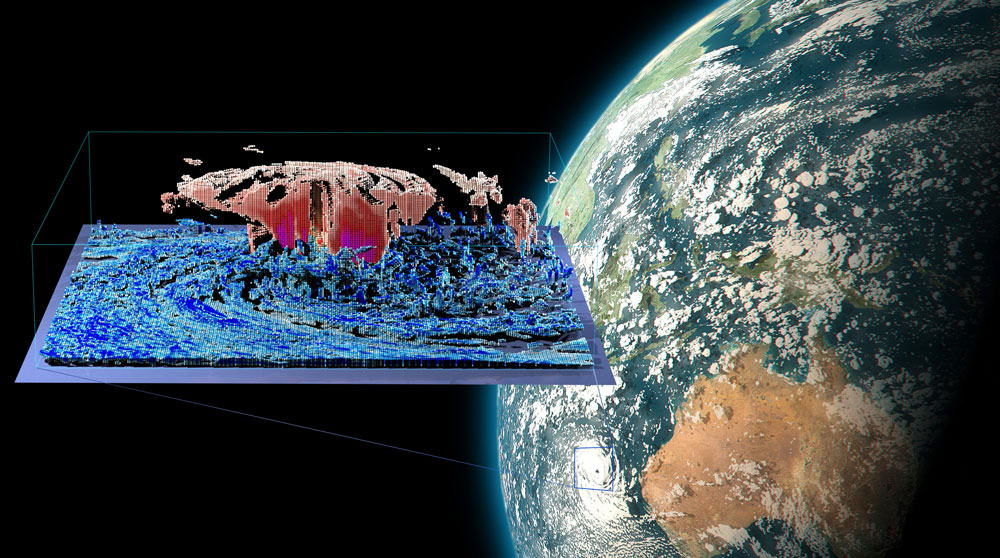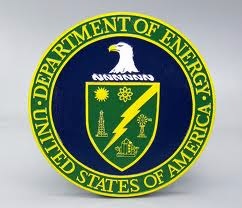From The DOE’s Sandia National Laboratories
4.6.23
NEAL SINGER
Simulations show a year’s climate in a research day

Focused on improving the accuracy of climate predictions, a Sandia-led computational team recently achieved a major milestone with a cloud-resolving model they ran on Frontier, the world’s first exascale supercomputer.
“We have created the first global cloud-resolving model to simulate a world’s year of climate in a day,” said Sandia researcher Mark Taylor, chief computational scientist of the Energy Exascale Earth System Model, or E3SM, an eight-lab project supported by the DOE’s Office of Science for the development of advanced climate models. “We’re ushering in a new era of accuracy.”
The E3SM model simulates critical aspects of Earth’s climate system that might impact conditions in the U.S. in the coming decades, including extreme temperatures, droughts, floods and a rise in sea level.
Clouds play a critical role in Earth’s climate system, impacting weather patterns and precipitation. “Traditional Earth system models struggle to represent clouds accurately,” Mark said. “This is because they cannot simulate the small overturning circulation in the atmosphere responsible for cloud formation and instead rely on complex approximations of these processes.”
The E3SM group developed an improved cloud-resolving atmosphere model named SCREAM, for Simple Cloud Resolving E3SM Atmosphere Model.
“This next-generation program has the potential to substantially reduce major systematic errors in precipitation found in current models,” Mark said, “because of its more realistic and explicit treatment of convective storms and the atmospheric motions responsible for cloud formation.”
These motions and their interactions determine many of the characteristics of regional precipitation, he said.
But the new model by itself was not enough. Running a simulation that resolves clouds globally over many decades requires tremendous computing resources to run in a reasonable amount of time. An exascale computer, executing more than a quintillion calculations per second — that’s the numeral 1 followed by 18 zeros — was just what was needed.

CLOUD PREDICTIONS — A snapshot from a cloud-resolving Simple Cloud Resolving E3SM Atmosphere Model simulation shows a tropical cyclone off the west coast of Australia. The global view displays clouds where the condensed water content is greater than 0.1 grams of water per kilogram of air. The inset shows a 3D cross section with ice mass in red and liquid cloud structure in blue. (Image by Brad Carvey)
Frontier, built under DOE auspices at The Oak Ridge National Laboratory, fills that bill, with more than 9,000 compute nodes. An E3SM team at Sandia worked to ensure SCREAM would run well on Frontier, other graphics processing unit-based systems and more conventional central processing unit-based supercomputers.
Frontier is expected to become a production-ready machine later this year but is not yet open for general access. However, through the DOE’s Exascale Computing Project, the E3SM developers had a 10-day window to test the performance of the new SCREAMv1 model running at a global 3.25-kilometer resolution. They obtained record-setting performance, with the atmosphere component running at greater than a simulated year per day.
SCREAM’s graphics processing unit performance, coupled with the exascale machine, for the first time will enable multiyear climate simulations with a more accurate treatment of clouds, leading to more accurate predictions of future weather and climate.
See the full article here .
Comments are invited and will be appreciated, especially if the reader finds any errors which I can correct. Use “Reply”.

five-ways-keep-your-child-safe-school-shootings
Please help promote STEM in your local schools.
![]()
Stem Education Coalition

Sandia National Laboratories managed and operated by the National Technology and Engineering Solutions of Sandia (a wholly owned subsidiary of Honeywell International), is one of three National Nuclear Security Administration research and development laboratories in the United States. Their primary mission is to develop, engineer, and test the non-nuclear components of nuclear weapons and high technology. Headquartered in Central New Mexico near the Sandia Mountains, on Kirtland Air Force Base in Albuquerque, Sandia also has a campus in Livermore, California, next to DOE’s Lawrence Livermore National Laboratory, and a test facility in Waimea, Kauai, Hawaii.
It is Sandia’s mission to maintain the reliability and surety of nuclear weapon systems, conduct research and development in arms control and nonproliferation technologies, and investigate methods for the disposal of the United States’ nuclear weapons program’s hazardous waste.
Other missions include research and development in energy and environmental programs, as well as the surety of critical national infrastructures. In addition, Sandia is home to a wide variety of research including computational biology; mathematics (through its Computer Science Research Institute); materials science; alternative energy; psychology; MEMS; and cognitive science initiatives.
Sandia formerly hosted ASCI Red, one of the world’s fastest supercomputers until its recent decommission, and now hosts ASCI Red Storm supercomputer, originally known as Thor’s Hammer.

Sandia is also home to the Z Machine.

The Z Machine is the largest X-ray generator in the world and is designed to test materials in conditions of extreme temperature and pressure. It is operated by Sandia National Laboratories to gather data to aid in computer modeling of nuclear guns. In December 2016, it was announced that National Technology and Engineering Solutions of Sandia, under the direction of Honeywell International, would take over the management of Sandia National Laboratories starting on May 1, 2017.



